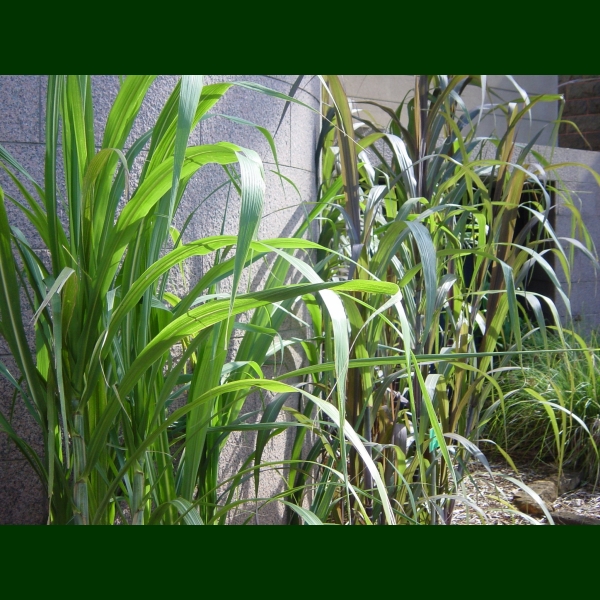 Hawaiian Name(s): kō
Hawaiian Name(s): kōScientific Name: Saccharum officinarum
Vernacular Name: sugarcane
Family: Poaceae
Status: Polynesian
Authority: L.
Description: Large perennial grass with hardened culms (stalks); forms thickets.
Habitat Most commonly cultivated in in a variety of lowland environments, on most main islands (Handy et al. 1972:186–187).
Medicines: Young leaf buds of the kō are mixed with kowali pehu vines (Ipomoea alba) and salt for pouring on deep cuts/wounds and compound fractures. Used for many medical purposes mixed with other plants, apparently as a sweetener, as many of the herbal remidies are bitter; it eliminates scarring as well (Abbott 1992:103; Chun 1994:152–155). For the illness hilo, waiki kō ‘aina kea is mixed with niu fruit (coconut, Cocos nucifera), and hau ka‘eka‘e and used as a topical remedy. Toasted cane juice used for ailing babies (Handy et al. 1972:187)
Non Medicinal Uses: Handy et al. (1972:187) state that the main use of kō was as a food. Normally a condiment, in times of famine a "life saver". Cane was chewed to harden gums. Used as inside wall covering (Abbott 1992:69). Kō charcoal used as a dye (Krauss 1993:65), cane for darts (Krauss 1993:89), and leaves for thatch (Degener 1930:58). In the Ethnology Collection at Bishop Museum there are post-contact examples of kō used in different types of hatbraids.
Specific gravity of wood: unknown
Famous Locations:
Mele:
`Ōlelo Noeau: [I] ‘Aina kō kiola wale ‘ia i ka nahele. Sugar-cane trash thrown in the wilderness. A derogatory expression applied to a person of no consequence. [II] He laukona ke kō, konakona ke aloha. Laukona is the sugar cane; love is despised. Laukona sugar cane was often used to free the victim of hana aloha sorcery. Instead of falling madly in love, the victim grew to dislike the subject. [III] He pa‘a kō lea no Kohala, e kole ai ka waha ke ‘ai. A resistant white sugar cane of Kohala that injures the mouth when eaten. A person that one does not tamper with. This was the retort of Pupukea, a Hawai‘i chief, when the Maui chief Makakuikalani make fun of his small stature. Later used in praise of the warriors of Kohala, who were known for valor. [IV] He papa‘a ke kō, pa‘a ke aloha. The papa‘a is the sugar cane that holds fast to love. Said of the papa‘a variety of sugar cane, used in hana aloha sorcery. [V] I ‘ike ‘ia no o Kohala i ka pae kō, a o ka pae kō ia kole ai ka waha. One can recognize Kohala by her rows of sugar cane which can make the mouth raw when chewed. When one wanted to fight a Kohala warrior, he would have to be a very good warrior to succeed. Kohala men were vigorous, brave, and strong. [VI] Ke kō ‘eli lima o Halali‘i. The sugar cane of Halali‘i, dug out by hand. Winds blowing over this place on Ni‘ihau buried the sugar cane. Here and there the leaves would be seen and the people would dig them out by hand. [VII] O ka li‘ili‘i pa‘a kokea ia Kohala, e kole ai kō nuku. It is the little white sugar stalk of Kohala that makes your mouth raw. Said by Pupukea when Makakuikalani make fun of his small size. The fine, hair-like growth on stalks of sugar cane can cause irritation. [VIII] Ola a kau kō kea. Lives till the sugar cane tassels. Said of one who lives until his hair whitens with age. [IX] Pau ke kō, ku ka he'e. When the sugar cane tassels, the octopus season is here. The sugar cane tassels in late October or early November. [X] Pau ke kō, ne‘e i ka he‘e holua. When the sugar cane tassels, move to the sledding course. The tops of sugar cane were used as a slippery bedding for the sled to slide on. [XI] Puhipuhi la‘u a kahuna, ka maunu loa‘a a ka pupuka. By blowing the medicine given by a kahuna, can the ugly gain his desire. Said of one who resorted to the prayers and ceremonies of a kahuna hana aloha to gain the love of his desired one. The person consulting the kahuna ate pilimai and manulele sugar cane after the kahuna had dedicated them to Makakanikkeoe, the love god. Then he blew in the direction of the desired person. The god, who also had a wind form, bore the mana along, and when it touched the one desired he or she became very much in love with the sender. When used with evil intent-for revenge or to humiliate-the sender is spoken of as an ugly person who has no charm of his own, hence he must resort to sorcery.
Dye Color and Parts: Black (leaf & stem charcoal)
Kino lau: KANE.
Location on Bishop Museum Kalihi Campus:
Propagation Information: (Handy et al. 1972:186).
